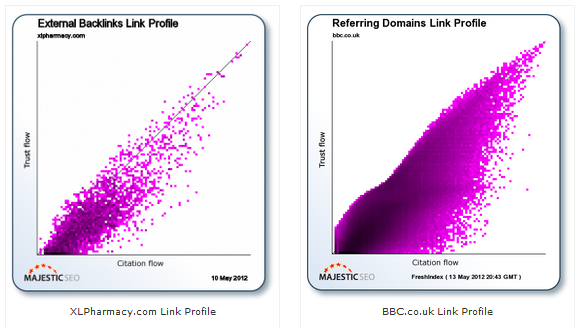In the last post of this series we revealed just how important backlinks are to your SEO.
If you want to be wowed click back and find out.
(It amazes us every time we look.)
But here’s the thing.
Links are important for SEO.
But not all links are equal.
We’re going to start by looking at how Google measures the authority of your site – and how you can assess the authority of others – before going on, in a later post, to look at the other factors that can affect the value of a link.
So if you want to understand what makes one site’s link more powerful for your SEO over another, then read on.
If you don’t, they do say the living is easy at the lower end of a Google search.
Why links matter for SEO – and why not all links are equal
As we’ve seen, one of the innovations behind the proto-Google search engine Backrub was its method of assessing which links were more important than others.
Named after Larry Page, this method of assessing links was named PageRank.
And some variant of it is still used by Google today, although its algorithm has changed much since then.
Google used to maintain a public display of PageRank for sites, via a browser toolbar plugin, but for years it had been apparent that it wasn’t updating its data. Although the public toolbar data is now dead this does not mean that Google is no longer using it for rankings.
It is the concept of PageRank rather than its actual values that you need to bear in mind.
PageRank is a measure of how trustworthy and authoritative a site or its content is.
Think about it for a moment… this means that not all links are equal.
And this is critical.
- A link from site A may be worth a lot less than a link from site B.
- Similarly, a link from page 1 on site A may be worth a lot less than a link from page 2.
A link from a highly trusted and authoritative site is going to pass on a lot more authority (or PageRank) to the page and the domain it links to.
How is authority passed on through backlinks?
A link to your site’s content is viewed as a vote of confidence from the page and site that creates the link.
You can also think of it as pat on the back, a name-check or being mentioned in a class assembly as pupil of the week.
If the page that links to yours has a high authority this is a much more influential vote of confidence than if it came from a page with a lower status.
Or, to put it another way, one link from a trusted, authoritative site is worth many links from a site without authority or any proof of trust.
Alternatives to the lost PageRank metric
So, PageRank has gone underground.
Only those in the Google bunkers have access to its metrics. And those of us optimising our websites are presumably left shooting in the dark like a hapless villain in a crime caper movie.
Yeah, right.
There are a number of alternative ways that SEO boffins have developed to try and mirror the way that Google measures the trust and authority of websites and their pages.
To switch on the lights and start targeting your link building and earning efforts you should plump for one of the backlink checkers that are available from Moz, Majestic or Ahrefs (details in ‘Find out more’ below.)
All of these consistently perform well in the best alternative PageRank competitions. And you are just in time to hear our favourites (Moz and Majestic) introduce themselves.
If you’d both just take to the stage and tell the judges about yourselves…

Majestic
“Hi, Majestic by name and by nature – but you can call me Maj!
I like to use Trust Flow and Citation Flow to compare domains and rank their pages.
I also have a cool feature called Topical Trust Flow that helps you to see what sectors or niches the sites that link to you come from.
Let me tell you how Trust and Citation Flow work.
You can think of Citation Flow as the amount of link juice a site will pass to you. It is a measure of its authority (based on the weight and number of links it has).
Trust Flow is a measure of the amount of trust a site that links to you can pass on. It is calculated by checking out the trust ‘heat’ of a site. Simply put trustworthy sites tend to link to trustworthy neighbours. These neighbours also tend to link to trustworthy neighbours themselves. And the deeper the trust network of a site the hotter it is, with those outside the circle of trust left in the cold.
Let me show you how my flows look when applied to two different sites.

This is an unfair comparison of a super-authoritative site (the BBC) and a much less dominant site. Sorry guys at the pharmacy!
But what does it show us?
Well, firstly the lower quality site has a lot less links. (No sherbet, Sherlock!)
But look again at where the links the Pharma site has are. The bulk of them (in the darker colours) are clinging to the lower part of the Trust axis.
Not good news for its rankings, I fear.
And that’s what I like helping people do: discovering where the links are that can skyrocket their rankings and helping them have a bit of a clean-up if it looks like Mr Spam has trashed the place.
Now, here’s a little secret: it’s easy to tell if your site shows signs of luncheon meat.
I have a little formula for it:
Trust Flow / Citation Flow = Trust Ratio
If the answer is above one: go get yourself a celebratory beer.
If it’s below one: perhaps you should review the links you have, deal with any that seem suspect and invest in a little quality content marketing!
That’s it, how did I do?”
Moz
“Hi, thanks Maj.
I’m Moz, but the only real way to shorten my name is to call me M.
Well, let’s be honest: it has been said that my link index data is not as robust as yours. But, shucks, people just love my SEO brand, so I’m mighty popular with the folks out there.
And, gee, I’ve heard it said that Ahrefs – who can’t be here tonight – is the one with the link index that catches all the most discerning eyes.
I can’t deny it. But, the thing is that when people think about measuring authority it is DA that springs to mind. And I don’t mean a haircut, or a swimming bird’s backside.
Domain Authority is abbreviated as DA, and it does what it says on the tin. Page Authority is abbreviated as PA, and it does pretty much the same but for pages.
I also offer some very similar metrics to your Citation and Trust Flow, called MozRank and MozTrust. The former measures link popularity and the latter measures link trust.
My MozTrust works a bit like that party game of six degrees of separation. I look at how far you are from a link from a source that has been identified as trusted, and I determine if I have to go through five connections to get to you or if I can do it, say, in two. The closer you are linked to a trusted website, the more trust I say you have.
I’m nice like that.
Hey, that’s it from me, but be sure to check out my regular video SEO tips here on Whiteboard Friday.
You’d never believe SEO could be so much fun.”
Thank you, contestants.
Look now they’re gone it’s only fair to say that they are far from the only tools that have risen to the challenge of providing an alternative to PageRank.
They are two of the most popular, however, and both are widely respected.
These tools can show you exactly which sites link to you, using which anchor text (the words that contain the link) and what the value of that link is to you. And they can show you the same about your competitors’ sites to.
The best thing you can do is have a play around – both offer free access to a limited extent – and check out the suggestions for discovering more about other tools below.
Find out more
- A thoughtful review of comparison studies of these tools can be found here.
- Discover the Ahrefs offering here.
- Delve into Majestic here and here, or check out this stunning collection of video tutorials here.
- Get to grips with Moz’s DA here, PA here, MozTrust here and MozRank here.
- And, don’t forget, the best SEO videos out there can be found fresh from the Moz HQ every Friday here.
In the next post we’ll look at other factors that affect how important a link may be to your site.
All the previous posts in this series can be found here.
For the complete version of this Fast track SEO course head over to Amazon.
It’s yours for less than a fiver!

